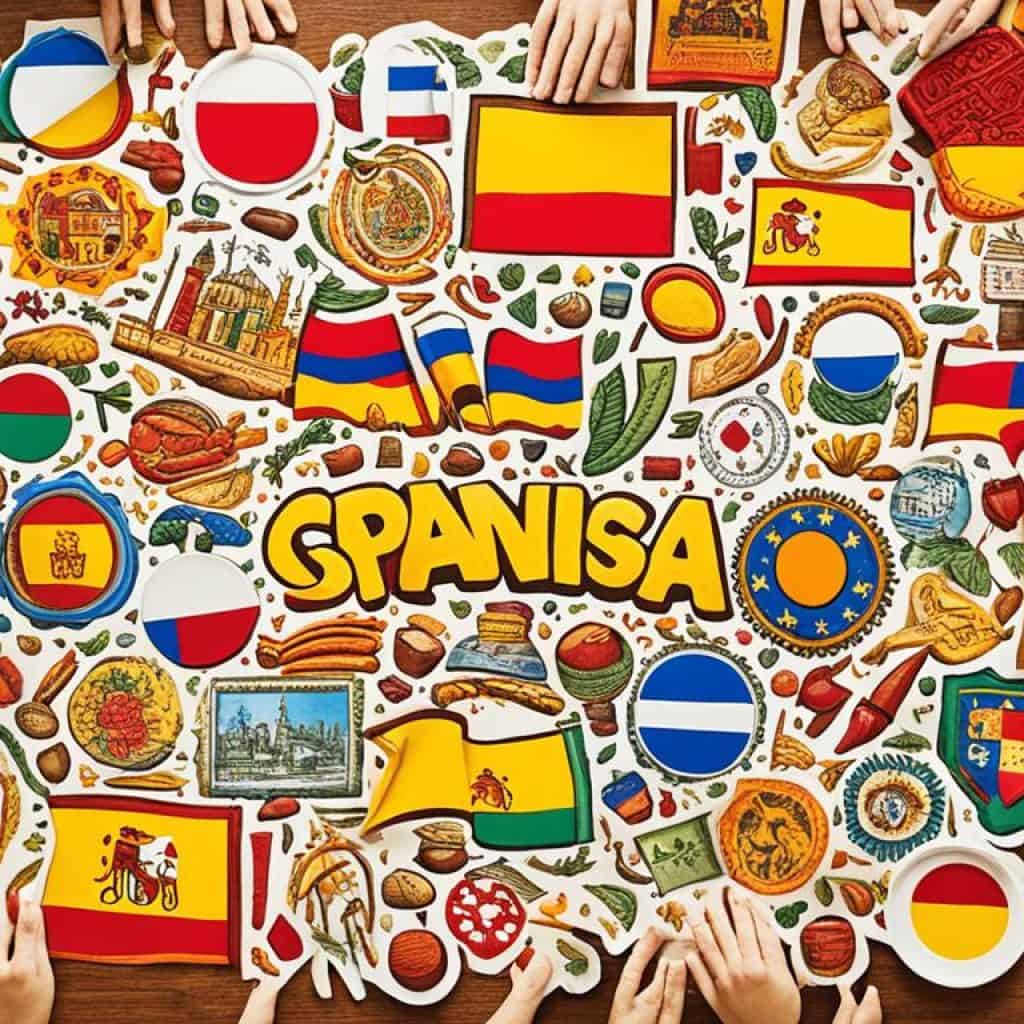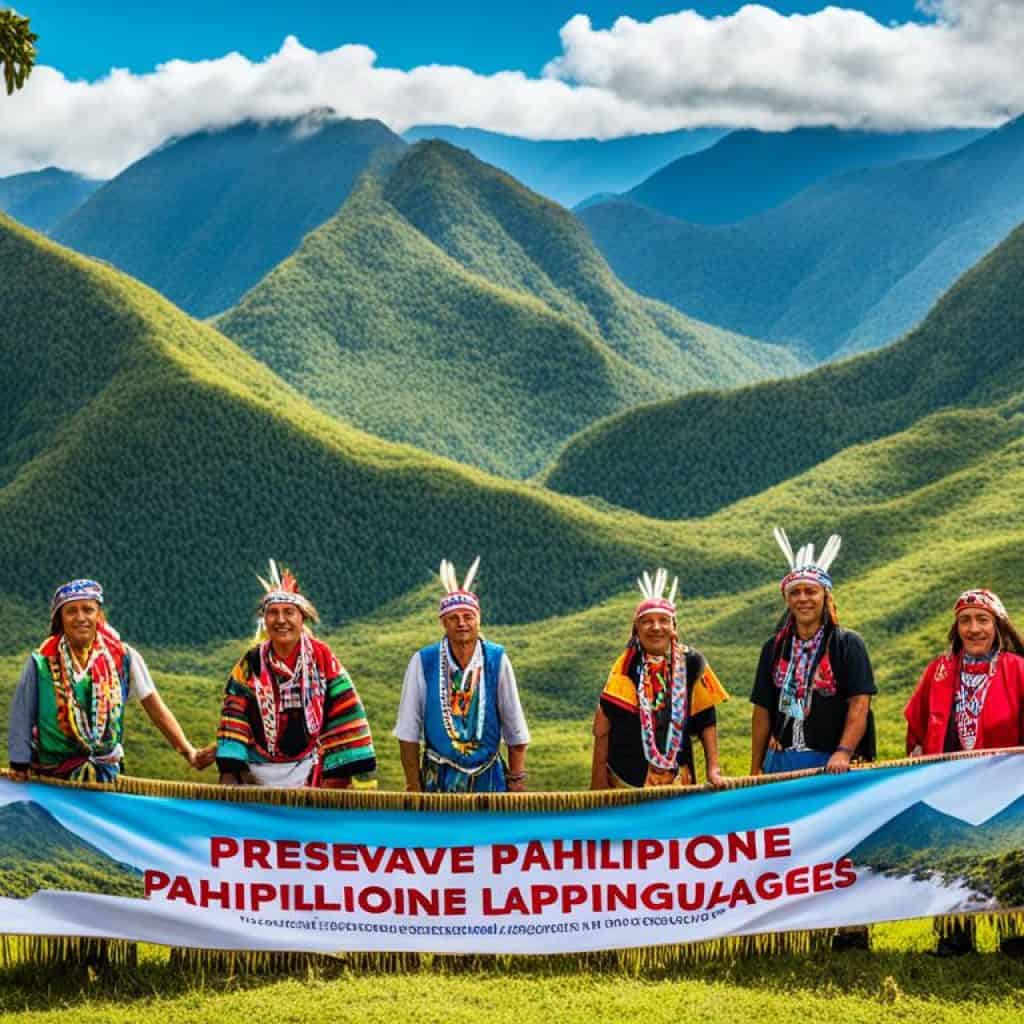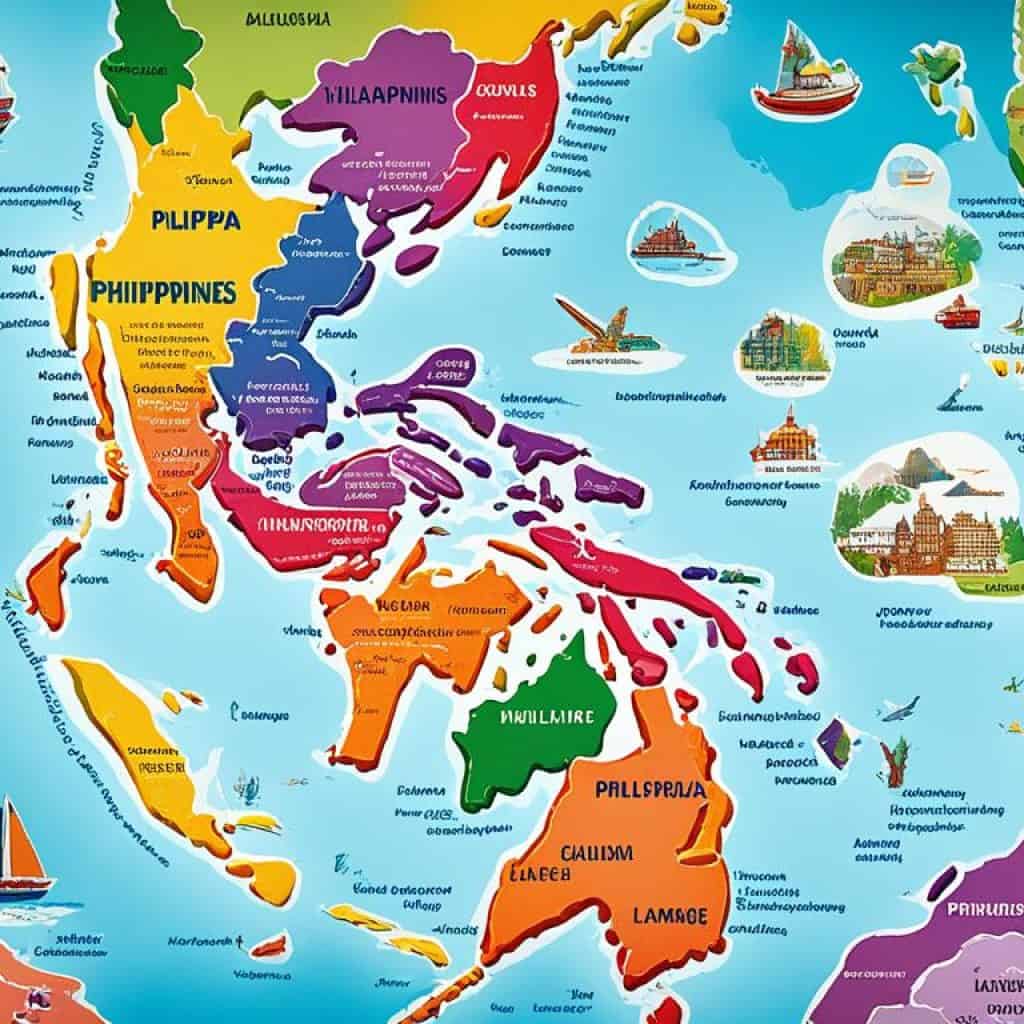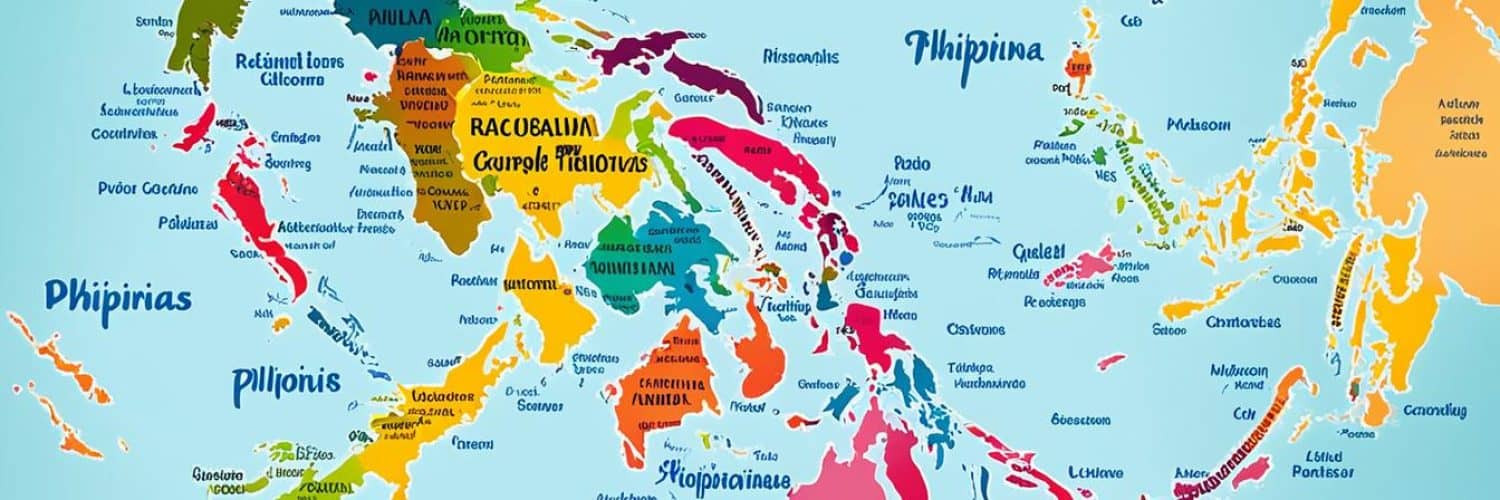Have you ever wondered just how many languages are spoken in the Philippines? It’s a question that may surprise you with its answer. When we think of language diversity, we often think of large countries like India or Africa, but the Philippines boasts an incredible linguistic landscape with over 170 distinct languages spoken throughout its 7,641 islands.
So, how many languages are there in the Philippines exactly? Which are the official languages? And what role do these languages play in the daily lives of Filipinos? Let’s take a deep dive into the linguistic diversity of the Philippines and unravel the fascinating tapestry of Philippine languages.
Key Takeaways:
- The Philippines is home to over 170 distinct languages.
- There are official and regional languages, as well as indigenous languages spoken throughout the country.
- Filipino and English are the official languages of the Philippines.
- Spanish has left a lasting impact on Philippine languages due to 300 years of colonial rule.
- Efforts are being made to preserve and revitalize endangered indigenous languages in the Philippines.
History of Spanish Influence on Philippine Languages
The Philippines has a rich linguistic heritage that has been shaped by its history of Spanish colonial rule. From 1565 to 1898, the Philippines was under Spanish control, and during this time, Spanish became the official language of the country. Although Spanish is no longer widely spoken in the Philippines today, its influence can still be seen in various aspects of Philippine languages.
One major impact of Spanish colonial rule on Philippine languages is the incorporation of Spanish loanwords into native languages. Many words and expressions from the Spanish language have been adopted and integrated into Filipino, the national language of the Philippines. These loanwords have enriched the vocabulary of Filipino and have become an integral part of daily conversations.
“Filipino people can still appreciate and recognize the historical influence of Spanish in our language,” says linguistics expert Dr. Maria Dela Cruz. “The Spanish loanwords add depth and cultural interconnectedness to our linguistic landscape.”
The Spanish influence on Philippine languages extends beyond vocabulary. The colonial period also had a significant impact on Filipino culture and society. The introduction of Spanish customs, traditions, and institutions influenced various aspects of Filipino life, including religion, education, and government.
“The Spanish language brought with it not just words but also cultural practices and ways of thinking,” explains historian Dr. Carlos Ramirez. “These influences are deeply ingrained in our society and continue to shape our collective identity.”
Spanish Loanwords in Filipino Language
The incorporation of Spanish loanwords into Filipino has resulted in a unique linguistic blend. Despite the changes in pronunciation and evolving meanings, these loanwords have become an essential part of Filipino vocabulary, contributing to the country’s linguistic diversity. Some examples of Spanish loanwords commonly used in Filipino include:
| Spanish Word | Filipino Translation | Meaning |
|---|---|---|
| Casa | Tahanan | Home |
| Libro | Aklat | Book |
| Salamat | Saludo | Thank you |
| Pluma | Pandikit | Pen |
These Spanish loanwords reflect the historical and cultural connections between the Philippines and Spain. They serve as a reminder of the shared history and influence that has shaped the Filipino language.
Influence on Regional Languages
The impact of Spanish colonial rule extends beyond Filipino and has influenced regional languages across the Philippines. Many local languages and dialects have also incorporated Spanish loanwords into their lexicons, creating a fusion of Spanish and indigenous elements.
“The Spanish influence can be seen in various regional languages, such as Cebuano, Ilocano, and Kapampangan, among others,” states linguist Dr. Sofia Cruz. “The interplay between Spanish and regional languages has resulted in unique dialects with distinct linguistic characteristics.”
This blend of languages reflects the cultural diversity of the Philippines and highlights the ongoing legacy of Spanish influence throughout the archipelago.
In conclusion, the Spanish colonial rule in the Philippines has left a lasting impact on Philippine languages. Spanish loanwords have become an integral part of Filipino vocabulary, reflecting the historical and cultural connections between the Philippines and Spain. The Spanish influence extends beyond Filipino and has influenced regional languages throughout the Philippines. Through the incorporation of Spanish loanwords, the Philippines continues to celebrate its linguistic diversity and preserve its unique cultural heritage.
Official Languages of the Philippines
The linguistic landscape of the Philippines is characterized by the presence of diverse languages and dialects. At the official level, the Philippines recognizes two languages: Filipino and English.
Filipino Language: Filipino is the national language of the Philippines and is primarily based on Tagalog, one of the native languages spoken in the country. It serves as the lingua franca, bridging the communication gap among the different linguistic communities in the Philippines. Filipino is widely spoken, understood, and used in various domains of daily life, including media, education, and government.
English Language: English holds a significant position in the linguistic landscape of the Philippines as the second official language. It plays a crucial role in government affairs, education, and business. English proficiency is highly valued and sought after by Filipinos. The widespread use of English contributes to the country’s global connectivity and enhances opportunities for international communication, trade, and education.
Together, Filipino and English provide a strong foundation for language proficiency and communication within the Philippines and with the global community. The recognition and use of these official languages demonstrate the commitment of the country to linguistic diversity and the promotion of effective communication across its various regions and communities.
Language Use and Policy
The choice of official languages in the Philippines reflects the country’s history and cultural diversity. Filipino, being based on Tagalog, represents the heritage and native language of a significant portion of the population. English, on the other hand, has its roots in the American colonial period and serves as a means of global communication.
The Philippine government acknowledges the importance of both languages and promotes their use through various language policies and legislation. These policies aim to ensure equitable access to education, official communication, and opportunities for social and economic development.
The use of Filipino and English as official languages not only facilitates intercultural communication but also strengthens national unity and identity. It creates a sense of belonging among Filipinos and reinforces cultural pride and heritage.
Comparison of Official Languages in the Philippines
| Languages | Role | Usage | Recognition |
|---|---|---|---|
| Filipino | National language | Media, education, government | Recognized as an official language in the Constitution |
| English | Second official language | Government, education, business | Recognized as an official language in the Constitution |
Filipino (Tagalog)
Filipino, which is based primarily on Tagalog, is the national language of the Philippines. Tagalog, an Austronesian language, is spoken by approximately 14 million native speakers in central Luzon and parts of Mindanao. It holds the distinction of being the second most widely spoken language in the country.
Filipino and Tagalog exhibit mutual intelligibility, allowing speakers of one language to understand and communicate effectively with speakers of the other. However, Filipino incorporates elements from various Philippine languages, as well as influences from Spanish, English, Chinese, and Malay, creating a vibrant and diverse linguistic tapestry.
Tagalog Language Overview
Tagalog belongs to the Austronesian language family, an expansive language group that encompasses numerous languages and dialects spoken throughout Southeast Asia and the Pacific. As one of the major languages in the Philippines, Tagalog plays a significant role in the cultural and social fabric of the nation.
Tagalog holds a special place in the hearts of Filipinos, serving as a symbol of national identity and unity.
With its rich vocabulary and expressive nature, Tagalog allows speakers to convey complex emotions and ideas. The language’s grammatical structure, characterized by its verb-initial word order and extensive use of affixes, adds depth and nuance to communication.
Native Tagalog Speakers
Tagalog is primarily spoken by native speakers in central Luzon, including the densely populated capital region of Metro Manila. Native Tagalog speakers are estimated to be around 14 million, forming a significant portion of the Philippines’ population.
Due to its widespread use and status as one of the official languages, many Filipinos learn Tagalog as a second language, contributing to its influence and reach across the country.
Mutual Intelligibility with Tagalog
Filipino, being heavily based on Tagalog, exhibits a high degree of mutual intelligibility with its parent language. Native Tagalog speakers can understand and communicate effectively with Filipino speakers, fostering mutual understanding and unity among different language communities in the Philippines.
This linguistic compatibility also facilitates communication and interaction between various regions and cultural groups in the country, ensuring a sense of inclusivity and national cohesion.
| Key Points about Filipino (Tagalog) |
|---|
| 1. Filipino is the national language of the Philippines, based primarily on Tagalog. |
| 2. There are approximately 14 million native Tagalog speakers in central Luzon and parts of Mindanao. |
| 3. Filipino and Tagalog are mutually intelligible, allowing effective communication between speakers of both languages. |
| 4. Tagalog belongs to the Austronesian language family, characterized by its expressive nature and unique grammatical structure. |
Cebuano (Bisaya)
Cebuano, also known as Bisaya, is the second most widely spoken language in the Philippines. It is primarily spoken in the Visayas and Mindanao regions. Cebuano is an Austronesian language with lexical influences from Spanish and English. It is spoken by more than 20 million native speakers and serves as a primary means of communication in these regions.
Key Characteristics of Cebuano:
- Native Cebuano Speakers: Over 20 million native speakers
- Geographical Distribution: Predominantly spoken in the Visayas and Mindanao regions
- Austronesian Language: Part of the Austronesian language family
- Lexical Influences: Borrowed words from Spanish and English
The Cebuano language, with its wide usage and rich vocabulary, plays an essential role in the cultural fabric of the Visayas and Mindanao regions. It enables effective communication among its native speakers, strengthening regional identities and fostering a sense of unity.
“Cebuano is not just a language; it is the key to unlocking the hearts and minds of the Visayan and Mindanaoan people, connecting them in their shared heritage.” – Cebuano language expert
With its strong presence in the Visayas and Mindanao regions, Cebuano serves as a crucial tool for cultural preservation and intergenerational communication. It allows for the transmission of traditions, folklore, and values from one generation to the next, ensuring the continuity of local customs and practices.
Moreover, the lexical influences from Spanish and English in Cebuano demonstrate the language’s adaptability and its ability to embrace external influences while retaining its distinct identity. The incorporation of Spanish and English loanwords adds linguistic depth and reflects historical connections with different cultures.
Overall, Cebuano, or Bisaya, represents the linguistic diversity and heritage of the Philippines. It stands as a testament to the country’s vibrant cultural tapestry and the unique linguistic expressions found throughout the archipelago.
Ilocano
Ilocano is a prominent language spoken in the Ilocos Region of Northern Luzon, Philippines. With approximately 10 million speakers, it is the third most spoken language in the country. The Ilocos Region, known for its picturesque landscapes and vibrant culture, is home to the Ilocano people who have preserved and nurtured their unique language over generations.
Ilocano has been influenced by various languages, particularly Spanish and English, resulting in an interesting blend of vocabulary and linguistic nuances. Spanish and English loanwords have been seamlessly incorporated into the Ilocano lexicon, enriching the language and reflecting historical connections with international cultures.
Ilocano serves as a powerful regional language, facilitating communication and cultural exchange among diverse communities in Northern Luzon. It is a language that fosters a sense of belonging and unity among the Ilocano people, connecting them through shared traditions, customs, and experiences.
Furthermore, Ilocano plays an integral role in preserving the cultural heritage of Northern Luzon. It is a language that carries the stories, values, and wisdom of the Ilocano people, allowing them to pass on their traditions from one generation to the next. Through the vibrant use of Ilocano, the cultural identity of the Ilocos Region remains strong and resilient.
Key Features of the Ilocano Language
“Ilocano is not just a language; it is the heartbeat of our community. It connects us to our roots and strengthens our sense of identity.” – Ilocano speaker
The Ilocano language is known for its distinct features, which contribute to its unique charm and beauty. Some notable characteristics of Ilocano include:
- Agglutinative nature: Ilocano heavily relies on affixation and reduplication to convey different grammatical meanings.
- Extensive vocabulary: With influences from Spanish, English, and other languages, Ilocano showcases a diverse vocabulary that reflects the rich history and cultural interactions of Northern Luzon.
- Ergative-absolutive alignment: Ilocano follows an ergative-absolutive alignment system, where the subject of an intransitive verb and the object of a transitive verb share the same form.
- Complex sentence structure: Ilocano exhibits complex sentence structures with multiple verb affixes, allowing for nuanced expression of actions, states, and conditions.
The beauty of the Ilocano language lies not only in its linguistic intricacies but also in its power to unite communities and preserve culture. It serves as a testament to the vibrant linguistic diversity of the Philippines, highlighting the richness and uniqueness of each regional language.
Spanish Influence on Philippine Languages
The Philippines has a rich linguistic history that includes a significant influence from the Spanish colonial rule, which lasted for 300 years, from 1565 to 1898. During this period, Spanish became the official language of the Philippines, leaving a lasting impact on the local languages.
Although Spanish is no longer widely spoken in the Philippines, its influence can be found in various aspects of Philippine languages. One notable effect is the incorporation of Spanish loanwords into native languages, including Filipino. These loanwords have become an integral part of the vocabulary and have contributed to the linguistic diversity in the country.
“The Spanish language left an indelible mark on Philippine culture and society. Through the integration of Spanish loanwords, Philippine languages have evolved into a unique blend of indigenous and foreign influences,” says linguistics expert, Dr. Maria Santos.
Furthermore, besides the linguistic impact, Spanish colonial rule also influenced Filipino culture and society as a whole. The introduction of Spanish customs, traditions, and religious practices shaped the cultural landscape of the Philippines.
Overall, the Spanish influence on Philippine languages signifies a shared history between the Philippines and Spain. It serves as a reminder of the country’s colonial past and the complex linguistic heritage that exists today.

| English Word | Spanish Loanword in Filipino |
|---|---|
| House | Tahanan |
| Food | Pagkain |
| Table | Mesa |
| Church | Simbahan |
| Friend | Kaibigan |
The table above provides examples of Spanish loanwords that are commonly used in Filipino. These loanwords reflect the lexical influence of the Spanish language on the Filipino vocabulary.
English
English has played a significant role in the linguistic landscape of the Philippines. It was introduced during the American colonial period, which spanned from 1898 to 1946, and has since become one of the official languages of the country. The influence of English can be seen in various aspects of Filipino society, including government, education, and business.
English serves as a bridge between the Philippines and the global community, facilitating communication and fostering international relationships. The country’s high level of English proficiency has contributed to its economic growth and competitiveness in the global market.
“English is a catalyst for success in the modern world.”
English Education in the Philippines
English education in the Philippines is highly valued and prioritized. The government has implemented various programs and initiatives to promote English proficiency among its citizens. English language courses are offered in schools and universities across the country.
The curriculum is designed to develop linguistic proficiency in both spoken and written English. Students are exposed to a wide range of English literature and are encouraged to engage in interactive language activities, such as debates and public speaking competitions.
English education in the Philippines equips students with the necessary language skills to communicate effectively in the global arena and opens up opportunities for further studies and employment both locally and internationally.
English Language Proficiency in the Philippines
The Philippines is renowned for its high level of English language proficiency. According to the EF English Proficiency Index, the country consistently ranks among the top countries globally in terms of English language skills.
| Year | Ranking |
|---|---|
| 2020 | 21st out of 100 countries |
| 2019 | 20th out of 100 countries |
| 2018 | 14th out of 88 countries |
The high English language proficiency in the Philippines can be attributed to the country’s English education system, exposure to English media and entertainment, and overall cultural attitudes towards the language.
In addition, many Filipinos possess excellent communication skills in English, making the country an attractive destination for outsourcing services and international business partnerships.
English language proficiency in the Philippines has proven to be a valuable asset, providing individuals with greater opportunities for personal, academic, and professional growth.
Overall, English has become deeply rooted in the fabric of Philippine society, contributing to the country’s cultural diversity, economic development, and global connectivity. The proficiency in English opens doors to international opportunities and acts as a driving force behind the advancement of the Filipino people. As the Philippines continues to embrace its linguistic diversity, English remains an essential tool for communication and success in the modern world.
Indigenous and Endangered Languages
Despite the linguistic diversity in the Philippines, many indigenous languages are endangered, with only a few thousand or even a few hundred speakers remaining. Efforts are being made to document, preserve, and revitalize these languages as they are an integral part of the country’s rich cultural heritage. These indigenous languages provide a window into the history, culture, and identity of the Filipino people.
In an era of globalization, the preservation of indigenous languages is crucial. These languages represent unique knowledge systems, customs, and traditions that have been passed down through generations. Without language preservation, the loss of these languages would mean a loss of cultural diversity and the erasure of significant cultural contributions.
Language revitalization programs play a vital role in sustaining and revitalizing endangered languages. These programs focus on language documentation, teaching, and community engagement. By creating resources such as dictionaries, grammar guides, and language-learning materials, these initiatives ensure that future generations have access to their native languages.
“Language is the vehicle through which cultures transmit their heritage. By preserving indigenous languages, we can safeguard the wisdom and knowledge embedded within them.”
Language preservation efforts also foster a sense of pride and identity among indigenous communities. Revitalizing their languages helps empower these communities, ensuring that their cultural traditions continue to thrive in the face of external pressures and social changes.
Beyond language preservation, the revitalization of endangered languages contributes to academic research and understanding. Indigenous languages provide valuable insights into linguistic diversity, helping researchers study language evolution, language contact, and the human mind’s capabilities for communication.
The Impact of Language Preservation:
The preservation of indigenous languages in the Philippines has far-reaching benefits that extend beyond cultural heritage. Here are some notable impacts:
- Community Empowerment: Language revitalization strengthens the cultural identity of indigenous communities, empowering them to preserve their heritage with pride.
- Cultural Resilience: Preserving indigenous languages helps safeguard indigenous customs, traditions, rituals, and storytelling traditions that are passed down orally.
- Inter-generational Connections: Language revitalization initiatives foster connections between younger and older generations, ensuring the transfer of traditional knowledge.
- Academic and Linguistic Contributions: Indigenous languages contribute to linguistic diversity research and advance our understanding of human cognition and linguistic capabilities.
- Language Diversity: The revitalization of endangered languages enriches the linguistic landscape, promoting diversity and inclusivity within society.
Efforts to preserve and revitalize indigenous languages are a collaborative endeavor involving community members, linguists, educators, and policymakers. By recognizing the value and importance of these languages, we can continue to promote cultural heritage, linguistic diversity, and the overall well-being of indigenous communities in the Philippines.
| Language | Status |
|---|---|
| Tagalog | Endangered |
| Ibanag | Severely Endangered |
| Kapampangan | Definitely Endangered |
| Tausug | Vulnerable |
| Ibaloi | Critically Endangered |
Efforts to Preserve Indigenous Languages
Various organizations and communities in the Philippines are actively engaged in preserving and revitalizing indigenous languages. These efforts aim to safeguard the linguistic heritage of the country and ensure the continued use of these languages by future generations.
Language Documentation Projects
Language documentation plays a crucial role in preserving indigenous languages. Linguists and researchers work closely with native speakers to document vocabulary, grammar, and cultural practices associated with these languages. Through meticulous recording and analysis, valuable linguistic resources are created, enabling a deeper understanding of these languages and their cultural significance.
Establishment of Language Schools and Programs
Recognizing the importance of indigenous languages, language schools and programs have been established in several regions of the Philippines. These institutions provide formal education in native languages, making learning accessible to individuals interested in preserving and revitalizing these languages. Language schools offer comprehensive curricula, including grammar, literature, and cultural studies, fostering a holistic approach to language education.
“Preserving indigenous languages is not just about words – it’s about preserving our cultural identity and passing on our traditions to future generations.” – Maria Santos, Language Preservation Advocate
Incorporation into Formal Education
Efforts are underway to incorporate indigenous languages into the formal education system. By integrating these languages into the curriculum, students gain a deeper understanding and appreciation for their cultural heritage. Indigenous language education allows learners to develop a strong connection to their ancestral roots, fostering a sense of pride and identity.
Additionally, the inclusion of indigenous languages in formal education promotes linguistic diversity and creates a more inclusive learning environment. Students from indigenous communities can express themselves in their native languages, breaking down barriers and creating a sense of belonging within the education system.
Language Revitalization Programs
Language revitalization programs are essential in preventing the loss of indigenous languages. These programs focus on creating opportunities for native speakers to use their languages in various contexts, such as community gatherings, traditional ceremonies, and cultural events. By promoting the active use of these languages, revitalization programs help in preserving linguistic diversity and promoting cultural continuity.
Language revitalization programs also empower indigenous communities to take ownership of their languages. Through community-led initiatives, language preservation becomes a collective effort, strengthening cultural pride and fostering intergenerational transmission of indigenous languages.

Language Education in the Philippines
Language education in the Philippines is a diverse and dynamic field, offering a wide range of opportunities for individuals to learn and develop proficiency in various languages. Schools across the country provide instruction in languages such as Filipino, English, and regional dialects, fostering linguistic diversity and cultural appreciation among students.
Bilingual and multilingual education programs have been implemented to promote language proficiency and enhance the educational experience of students. These programs recognize the value of multilingualism, enabling students to develop fluency in multiple languages while embracing their cultural heritage.
Language schools and online courses are also available for individuals looking to learn specific Philippine languages or seeking to improve their language skills. These language learning programs offer comprehensive curricula taught by experienced instructors, providing learners with a structured and supportive environment to enhance their linguistic abilities.
Language education is not only about imparting linguistic knowledge; it is also about fostering cultural understanding and promoting global citizenship. By learning different languages, individuals gain insights into diverse cultures and perspectives, heightening their intercultural competence and expanding their opportunities in today’s interconnected world.
Benefits of Language Education
Language education in the Philippines offers numerous benefits for individuals, both academically and personally. Here are some of the key advantages:
- Enhanced cognitive skills: Learning multiple languages has been shown to improve cognitive abilities such as problem-solving, critical thinking, and multitasking.
- Improved communication skills: Proficiency in multiple languages broadens communication channels, allowing individuals to connect with a wider range of people and communities.
- Cultural appreciation: Language education fosters an appreciation for diverse cultures and traditions, promoting respect, empathy, and intercultural competence.
- Expanded career opportunities: Bilingual or multilingual individuals have a competitive edge in the global job market, as they can communicate effectively with international partners and clients.
- Personal growth: Language learning enhances self-confidence, adaptability, and open-mindedness, enabling individuals to embrace new experiences and enrich their personal lives.
By investing in language education, both individuals and society as a whole can reap the rewards of a linguistically and culturally diverse environment.
Language Diversity in Philippine Society
The linguistic diversity of the Philippines has had a profound impact on its society, influencing daily interactions and shaping cultural practices. With over 170 languages spoken across the country’s 7,641 islands, linguistic diversity is a central feature of Filipino identity. This diversity is a result of historical language contact, migration, and the coexistence of indigenous languages with the official languages of Filipino and English.
One notable characteristic of language diversity in the Philippines is code-switching, in which individuals seamlessly switch between different languages or dialects depending on the context. Code-switching allows Filipinos to express themselves effectively and adapt their communication style to the situation at hand. This linguistic versatility fosters social cohesion and strengthens relationships among individuals from different linguistic backgrounds.
Language variation is also prevalent in the Philippines, with different regions and communities having their own distinct linguistic features. This variation contributes to the overall richness of linguistic diversity in the country. It reflects the diverse history and cultural influences that have shaped the development of local languages and dialects.
Language policies and language planning are important in promoting and preserving linguistic diversity in the Philippines. These policies aim to ensure equitable access to education and services for all language communities, address language inequalities, and celebrate the cultural heritage embedded in each language. Efforts are made to preserve and revitalize endangered languages, as they carry the collective memory and wisdom of indigenous communities.
“Linguistic diversity in the Philippines is a unique and valuable asset that should be celebrated and nurtured. It is a reflection of our shared history, cultural heritage, and national identity.”
Figures and Statistics
| Linguistic Aspect | Statistics |
|---|---|
| Languages Spoken | Over 170 languages |
| Code-Switching | Common practice |
| Language Variation | Distinct linguistic features in various regions |
Note: These figures are estimates and may vary depending on sources and criteria used for classification.
The table above provides an overview of the linguistic aspects in Philippine society. It shows the number of languages spoken, the prevalence of code-switching, and the existence of language variation.
Overall, linguistic diversity in the Philippines is a valuable cultural asset that reflects the country’s rich history and diverse heritage. By promoting language policies that recognize and celebrate this diversity, the Philippines can ensure the preservation and vitality of its unique linguistic tapestry for future generations.
Language Learning Opportunities in the Philippines
If you’re interested in learning Philippine languages, the Philippines offers a wide range of language learning opportunities to suit your needs. With language schools, online courses, immersion programs, and language exchanges, there are options available for learners of all levels.
Language Schools
Language schools in the Philippines provide comprehensive language courses taught by native speakers. These schools offer structured programs that focus on grammar, vocabulary, pronunciation, and conversational skills. Whether you prefer an intensive course or a more relaxed pace, language schools cater to a variety of learning styles.
Online Language Courses
If you prefer the flexibility of learning from the comfort of your own home, online language courses are an excellent option. With virtual classrooms and interactive lessons, you can learn at your own pace and access resources from anywhere in the world. Online language courses provide convenience and accessibility without compromising on quality.
Immersion Programs
For those seeking a more immersive language learning experience, immersion programs in the Philippines are an ideal choice. These programs offer the opportunity to live in a local community and fully immerse yourself in the language and culture. By surrounding yourself with native speakers and practicing in real-life situations, you’ll accelerate your language proficiency and gain a deeper understanding of the culture.
Language Exchange
Language exchange activities provide a fun and interactive way to practice your language skills with native speakers. These exchanges allow you to meet and connect with local Filipinos who are interested in language learning as well. Through conversations, cultural exchanges, and shared experiences, you’ll improve your language skills while forging meaningful connections.
“Language learning is a journey of discovery, and the Philippines offers a diverse and immersive environment to enhance your language skills. From formal language schools to cultural exchanges, the opportunities are endless. Embrace the rich linguistic tapestry of the Philippines and embark on a rewarding language learning adventure.”
| Language Learning Opportunities in the Philippines | Benefits |
|---|---|
| Language Schools |
|
| Online Language Courses |
|
| Immersion Programs |
|
| Language Exchange |
|

Importance of Language in Cultural Identity
Language holds a profound significance in shaping and expressing the cultural identity of the Filipino people. It serves as a powerful vehicle for preserving and celebrating traditions, beliefs, and values that have been passed down through generations. Language connects individuals to their roots and provides a sense of belonging to a vibrant cultural tapestry.
Preserving and revitalizing indigenous languages is crucial for safeguarding cultural heritage and promoting cultural diversity in the Philippines. These languages are repositories of ancient wisdom, folklore, and oral traditions that embody the unique experiences and perspectives of specific communities. By preserving indigenous languages, we ensure that their rich cultural heritage is retained for future generations to appreciate and learn from.
Furthermore, the revitalization of indigenous languages helps foster cultural pride and self-identification. When communities actively engage in language revitalization efforts, they not only strengthen their connection to their cultural traditions but also experience a renewed sense of purpose and belonging. Language becomes a tool for reclaiming and reaffirming cultural identity.
“Language nurtures cultural identity by serving as a vessel for preserving and passing down the collective knowledge and heritage of the Filipino people.”
Language acts as a lens through which the world is perceived, and it shapes the way individuals express their thoughts, emotions, and worldviews. Each Philippine language reflects the unique cultural perspectives, historical influences, and local contexts of the communities that speak them. By embracing and promoting linguistic diversity, we celebrate the multifaceted nature of Filipino culture.
The importance of language in cultural identity goes beyond mere communication. It is intertwined with personal and collective narratives, beliefs, and values. Language revitalization efforts not only preserve the linguistic diversity of the Philippines but also contribute to the holistic preservation of cultural practices, rituals, and customs.
Preserving Cultural Heritage through Language Revitalization
Language revitalization initiatives play a crucial role in preserving cultural heritage. These efforts typically focus on documenting endangered languages, creating language learning resources, supporting community-driven language schools, and integrating indigenous languages into formal education systems. By revitalizing languages, we ensure that cultural traditions and knowledge are not lost to the passage of time.
Cultural Diversity and Linguistic Richness
The diverse languages spoken in the Philippines reflect the country’s cultural diversity and contribute to its linguistic richness. By valuing, protecting, and promoting these languages, we honor the multifaceted identities of the Filipino people and contribute to the cultural landscape of the nation.
Language and culture are deeply interconnected. Language acts as a bridge that connects communities, generations, and cultural practices. It is a source of pride, a tool for self-expression, and a foundation for cultural continuity. By recognizing the importance of language in cultural identity, we can foster a society that cherishes its diverse cultural heritage and celebrates linguistic diversity.
The Future of Linguistic Diversity in the Philippines
The linguistic diversity in the Philippines has been a significant part of its cultural heritage for centuries. However, the future of this diversity relies on various factors, including language revitalization efforts, language policies, and socio-cultural changes.
Language revitalization efforts play a crucial role in preserving and promoting indigenous languages in the Philippines. These efforts involve language documentation, language schools, and programs focused on language revitalization and preservation. By recognizing the value of these languages and supporting their continued use, the Philippines can ensure the survival of its linguistic diversity.
Language policies also play a vital role in shaping the future of linguistic diversity in the Philippines. Policies that prioritize the preservation and promotion of indigenous languages help create an environment where linguistic diversity thrives. These policies can include the integration of indigenous languages into education systems, government initiatives to support indigenous languages, and the recognition of linguistic rights.
Additionally, socio-cultural changes can have a significant impact on linguistic diversity. Globalization and language shift pose challenges to the preservation of indigenous languages. However, by promoting language maintenance and creating opportunities for language use in various domains, such as media, arts, and cultural events, the Philippines can foster a climate of language maintenance and revitalization.
“Linguistic diversity is a precious resource that reflects the rich tapestry of cultures in the Philippines. By embracing this diversity and implementing language revitalization efforts, we can ensure that future generations continue to celebrate and appreciate the unique linguistic heritage of our nation.”
In conclusion, the future of linguistic diversity in the Philippines relies on language revitalization efforts, supportive language policies, and socio-cultural changes. By recognizing the value of linguistic diversity and actively working towards its preservation, the Philippines can safeguard its unique cultural identity and heritage for generations to come.
| Factors Influencing the Future of Linguistic Diversity in the Philippines |
|---|
| Language Revitalization Efforts |
| Language Policies |
| Socio-Cultural Changes |
Conclusion
The Philippines is a linguistically diverse country, boasting a rich tapestry of over 170 languages spoken across its multitude of islands. While Filipino and English serve as the official languages, it is imperative to recognize and preserve the indigenous languages that contribute to the country’s cultural heritage.
Language education programs play a vital role in maintaining linguistic diversity, ensuring that future generations can connect with their roots and appreciate the unique linguistic fabric of the Philippines. These programs, coupled with language documentation and revitalization efforts, are crucial for ensuring the survival and thriving of indigenous languages.
By embracing linguistic diversity and celebrating the multitude of languages that comprise its identity, the Philippines showcases its commitment to preserving cultural heritage and fostering an inclusive society. Language preservation is not just about communication; it is a testament to the resilience and richness of the Filipino people and their diverse traditions.














Add comment